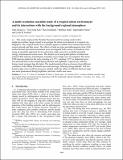| dc.contributor.author | Li, Xian-Xiang | |
| dc.contributor.author | Koh, Tieh Yong | |
| dc.contributor.author | Entekhabi, Dara | |
| dc.contributor.author | Roth, Matthias | |
| dc.contributor.author | Panda, Jagabandhu | |
| dc.contributor.author | Norford, Leslie Keith | |
| dc.date.accessioned | 2014-09-09T19:04:36Z | |
| dc.date.available | 2014-09-09T19:04:36Z | |
| dc.date.issued | 2013-09 | |
| dc.identifier.issn | 2169897X | |
| dc.identifier.uri | http://hdl.handle.net/1721.1/89399 | |
| dc.description.abstract | This study employed the Weather Research and Forecasting model with a single-layer urban canopy model to investigate the urban environment of a tropical city, Singapore. The coupled model was evaluated against available observational data from a sensor network and flux tower. The effects of land use type and anthropogenic heat (AH) on the thermal and wind environment were investigated with a series of sensitivity tests using an ensemble approach for low advection, high convective available potential energy, intermonsoon season cases. The diurnal cycle and spatial pattern of urban heat island (UHI) intensity and planetary boundary layer height were investigated. The mean UHI intensity peaked in the early morning at 2.2°C, reaching 2.4°C in industrial areas. Sea and land breezes developed during daytime and nighttime, respectively, with the former much stronger than the latter. The model predicted that sea breezes from different coastlines of the Malay Peninsula meet and converge, inducing strong updrafts. AH was found to play roles in all the processes studied, while the effect of different land use types was most pronounced during nighttime, and least visible near noon. | en_US |
| dc.description.sponsorship | Singapore. National Research Foundation (Singapore MIT Alliance for Research and Technology (SMART), Center for Environmental Sensing and Modeling (CENSAM)) | en_US |
| dc.description.sponsorship | National University of Singapore (Research grant R-109-000-091-112) | en_US |
| dc.language.iso | en_US | |
| dc.publisher | American Geophysical Union | en_US |
| dc.relation.isversionof | http://dx.doi.org/10.1002/jgrd.50795 | en_US |
| dc.rights | Article is made available in accordance with the publisher's policy and may be subject to US copyright law. Please refer to the publisher's site for terms of use. | en_US |
| dc.source | Other univ. web domain | en_US |
| dc.title | A multi-resolution ensemble study of a tropical urban environment and its interactions with the background regional atmosphere | en_US |
| dc.type | Article | en_US |
| dc.identifier.citation | Li, Xian-Xiang, Tieh-Yong Koh, Dara Entekhabi, Matthias Roth, Jagabandhu Panda, and Leslie K Norford. “A Multi-Resolution Ensemble Study of a Tropical Urban Environment and Its Interactions with the Background Regional Atmosphere.” Journal of Geophysical Research: Atmospheres 118, no. 17 (September 13, 2013): 9804–9818. | en_US |
| dc.contributor.department | Massachusetts Institute of Technology. Department of Architecture | en_US |
| dc.contributor.department | Massachusetts Institute of Technology. Department of Civil and Environmental Engineering | en_US |
| dc.contributor.mitauthor | Norford, Leslie Keith | en_US |
| dc.contributor.mitauthor | Entekhabi, Dara | en_US |
| dc.relation.journal | Journal of Geophysical Research: Atmospheres | en_US |
| dc.eprint.version | Final published version | en_US |
| dc.type.uri | http://purl.org/eprint/type/JournalArticle | en_US |
| eprint.status | http://purl.org/eprint/status/PeerReviewed | en_US |
| dspace.orderedauthors | Li, Xian-Xiang; Koh, Tieh-Yong; Entekhabi, Dara; Roth, Matthias; Panda, Jagabandhu; Norford, Leslie K | en_US |
| dc.identifier.orcid | https://orcid.org/0000-0002-5631-7256 | |
| dc.identifier.orcid | https://orcid.org/0000-0002-8362-4761 | |
| mit.license | PUBLISHER_POLICY | en_US |
| mit.metadata.status | Complete | |
